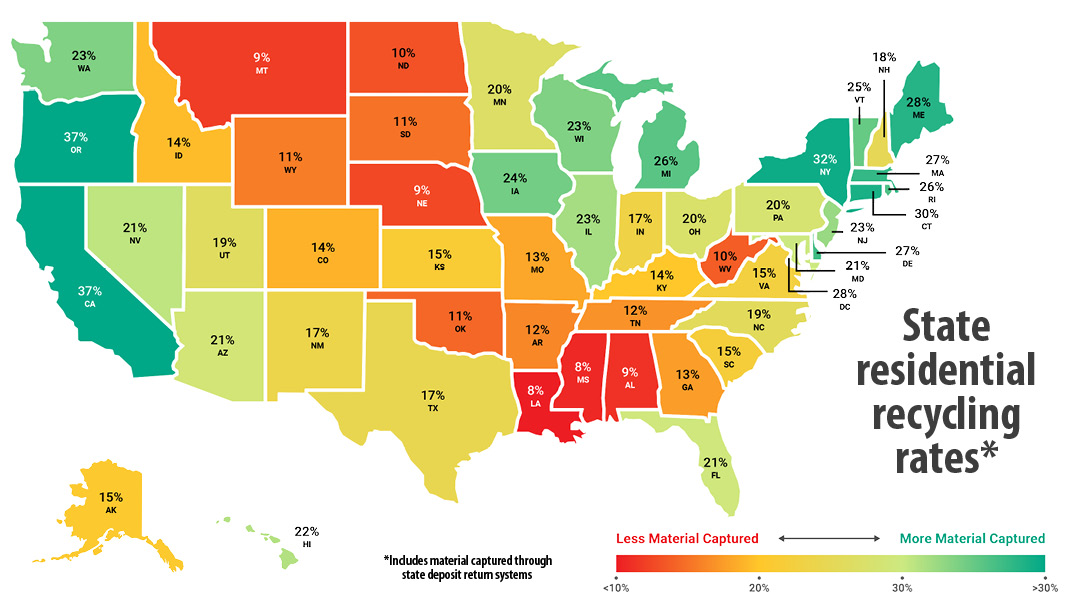Top: State-by-state recycling rates. Graphic courtesy The Recycling Partnership
The Recycling Partnership (TRP) released “State of Recycling: The Present and Future of Residential Recycling in the U.S.” on January 10, and the picture it paints is anything but rosy. “Based on a new methodology that tracks the fate of materials in the system, including material from single-family and multifamily homes, and includes film and flexible material, 21% of recyclable material is being recycled in the U.S.,” states the report. “Out of the 79% of lost material, 76% is lost at the household level and not collected, underscoring the importance of recycling access and household engagement.”
According to TRP, 85% of single-family households have access to recycling, and among multifamily households, only 37% have recycling access. “Currently, just 43% of households participate in recycling,” notes TRP. “… In an effective system at least 90% of households would participate. This underscores the need for investment in communication, outreach and support.” Of the recyclables that make it to the materials recovery facilities, “we estimate that 87% of material is sorted and sent to market,” says TRP. “Recycling facilities should be able to process 95% of the recyclable material they receive into saleable commodities.” The Partnership’s data indicates that the capture rate is highest for cardboard (81%), followed by glass containers (62%), mixed paper (60%) and high-density polyethylene bottles and jars (59%). Film and flexible items top the list of what ends up in the trash (80%), followed by polypropylene (70%), non-bottle PET (57%), steel cans (53%) and cartons (50%). Surprisingly, only 55% of aluminum cans are captured. The low rate for film and flexible material capture is attributed to the reality that very few curbside programs accept it. “We capture less than 1% of the nearly 4.8 million tons generated annually,” says the report. “However, as film and flexible material becomes more prevalent in products, investment in the recyclability of this material is needed.”
“State of Recycling” includes two maps that capture recycling data by state. The first, state-by-state residential recycling rates (see feature image, above), shows that California and Oregon have the highest recycling rates (37%), followed by New York State (32%), Connecticut (30%) and Maine and the District of Columbia (both 28%). States with the lowest rates include Alabama, Montana, Nebraska (all 9%) and Louisiana and Mississippi (8%). In terms of states with the highest tonnages of recyclable materials lost (Figure 1), California and Texas are tied at 3.2 million tons, followed by Florida (2.4 million tons), New York (1.9 million tons), Pennsylvania (1.6 million tons) and Ohio and Illinois (1.5 million tons).
For the recycling system in the U.S. to be effective, five requirements must be met, explains TRP:
- 100% of packaging needs to be recyclable
- 100% of households need access to recycling
- Residents need to fully engage in recycling
- Recycling facilities need to effectively process 95% of the material received
- Recycling facilities need sufficient end markets
To meet these requirements, TRP identifies three key strategies: Extended Producer Responsibility (EPR) adoption to require companies that produce materials to take financial and environmental responsibility for the full life cycle of their products; Proactive regional investments in the recycling system; and Investment in recycling engagement. “Our research has consistently shown that people want to recycle and understand the importance of recycling, but they lack confidence to do so and are confused about the latest recycling rules,” says TRP. “Whether through EPR fees or proactive investment, private industry needs to support communication, public engagement, and in-home tools to help overcome these barriers.”














